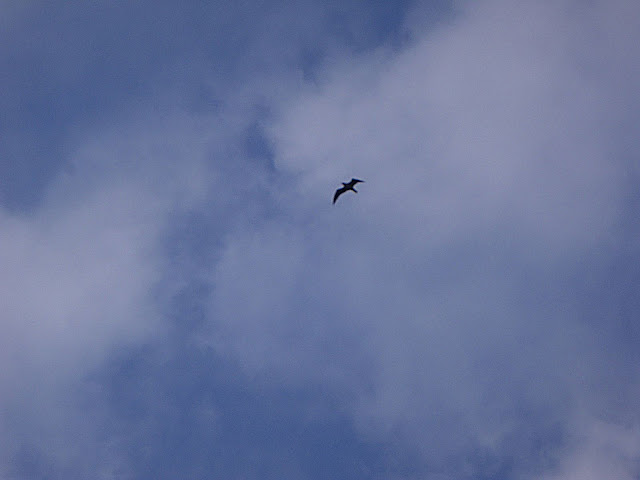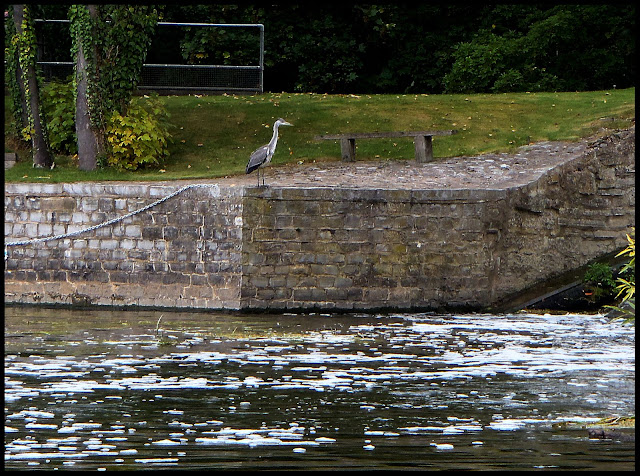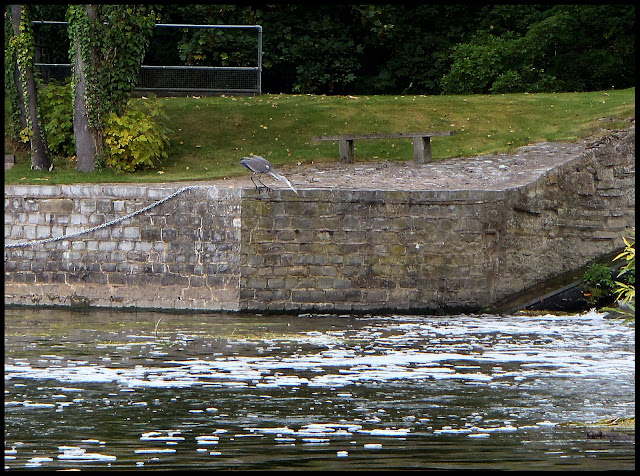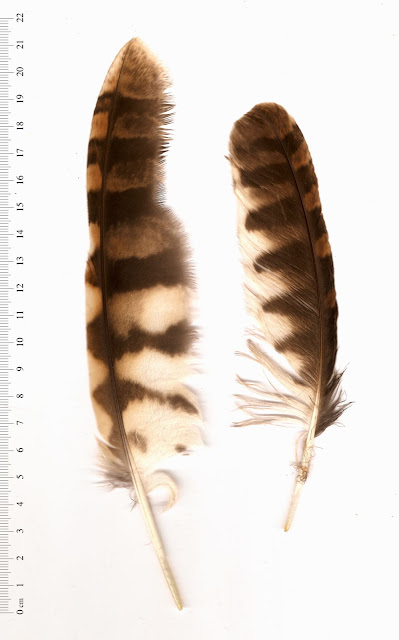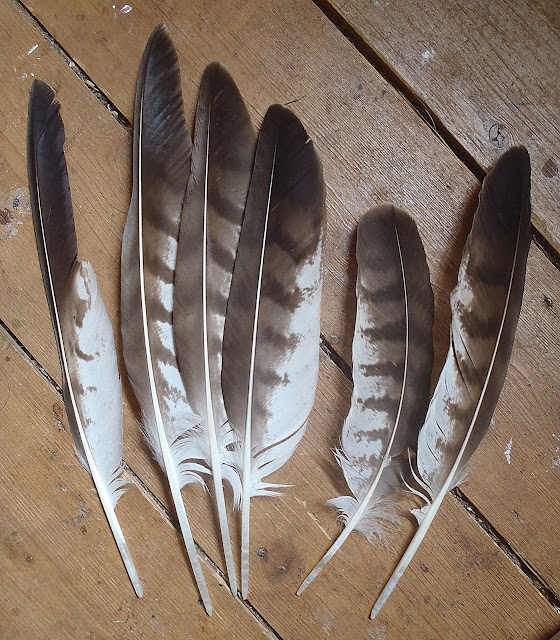The first time I saw the Longford Buzzards was a couple or three years ago now. There's a particular oak tree gracing an ancient meadow that abuts the M6 (to the South) where I spotted a large bird perching atop a dead branch. When it flew off, as I have found they always will whenever you get within 100 yards of them, I saw it was a buzzard.
I've seen that solitary bird many times since perching in the same place at various times through the year though there are long periods when it is absent, or seems so. I once saw a pair soaring high above the same area above the motorway and over the nearby Coventry Canal but never ever saw a pair in that meadow. I'd guessed the bird I'd seen there was a loner. It never occurred to me to go find its feathers but this year I took a look and found a couple of tails feathers - one centre feather under the tree and one outside feather under another large oak 50 yards away. They were from the same bird. A perfect match...
I then met the landowner who wanted to know why I was trawling about on his land. I explained and offered him one of the tail feathers and he then gave me permission to trawl at will seeing as he was interested in the bird himself, had a theory that it nested in the trees by the M6, and was chuffed to now have a feather from it. I made a mistake by giving him the centre feather, which in a lapse of judgement I'd failed to photograph with its sister, as it struck me then that I'd hit upon a theory - that buzzards can be fingerprinted and traced by the tail feathers which do seem unique in pattern bird by bird unlike the wing feathers which seem standard in pattern to all buzzards.
I've returned a number of times to those oaks and found one of the minor coverts among many flank and breast feathers and the remains of a number meals directly beneath them both including two black and red/brown wing feathers from I can only guess was a domestic fowl of some sort, a long thin dark brown primary that I cannot easily pin down but looks just like a overgrown swift (if it is a swift then it's from an alpine swift which is a proper rarity in England) a skeletal song thrush identified by its feathers, an immature kestrel who's various feathers were scattered about in the ditch but no bodily remains were seen and the centre lining of a nest of some species or another presumably plucked out of a bush complete with eggs, or even along with the chick...who knows?
 A young kestrel's feathers and the lining of a nest in the ditch below the perch
A young kestrel's feathers and the lining of a nest in the ditch below the perch
I'd guess the bird took it off to another safe site to finish the yougster off when a dog walker passed by - these suburban buzzards might be venturing ever closer to city life but they are still extremely cagey when it comes to close proximity to visible humans. I've tried for a photo of the bird on its perch many times but only ever have caught empty air above that stark grey stick as they bird spooks and swoops down and away to the safety of the dense dark birch wood along the motorway embankment...
 The kestrel chick's underdeveloped primary hung up on twig - I'd suppose this is evidence that the bird was eaten above the ground?
The kestrel chick's underdeveloped primary hung up on twig - I'd suppose this is evidence that the bird was eaten above the ground?
Talking about kestrels I should mention that the very next day Judy plucked a mature kestrel's right wing primary out of the long grass in the very next meadow, a meadow that runs along the cut and the next morning while walking Molly in that same place I saw the bird itself flushed off its canal side perch by the dog . It looked to be minus too many tail feathers for its own good though I haven't found one yet. I have found another matching left primary since, from a field a quarter of a mile distant and right by the M6, but don't think it is from the same bird as the two are different in colour saturation unless one is older and the other fresher? Possibly they are both from a mating pair who ply their trade on the motorway embankments?
 Two primaries from the local kestrels and the secondary of one from Harvington
Two primaries from the local kestrels and the secondary of one from Harvington
In the same field I have also come across numerous uncleared platters including a blackbird (a set of tail feathers only) and a domestic chicken evidenced by a puff of yellow breast feathers and two feral pigeons. These meals are always taken at the side of the field but I cannot say for sure whether or not they are the meals of an identifiable species though the picture below is likely to be that of a buzzard if it's not that of a fox (no buzzard feathers found nearby) as it's a feral pigeon found one week in the field corner right by the M6 and the leg of a rabbit overlain on the same spot the next...
 Feral pigeon and rabbit meals by the motorway - obviously this is its usual table at the restaurant!
Feral pigeon and rabbit meals by the motorway - obviously this is its usual table at the restaurant!
I then located another perch in a big old oak (what else!) in the middle of another set of horse meadows near to Wiken Slough. I suspected there would another favoured perch in the vicinity somewhere and went looking under every sizeable oak I could find around the Slough but without luck until I spotted what I thought might just be a feather fluttering in the distance beneath an oak in a fenced off horse field. I hopped over the gate and went to investigate.

I was a buzzard secondary and a second smaller secondary lay nearby....

There was also a trampled minor primary and lots of breast and flank feathers beneath that oak and out in the field a way, but no evidence whatsoever of meals, and then caught sight of the bird as it soared above the motorway a quarter of a mile away.
I tried for a photo but got only a speck in the sky on full zoom...

This is a site just a half a mile from the first and another perch near to the motorway which runs a couple of hundred yards to the North. I'm wondering if this (or these?) buzzard has taken to the motorway as its source of fresh carrion? It would make sense as every sighting and find has come from within spitting distance of it.
As for raptors apart from those mentioned I've also seen - though glimpses of a streak of blue-grey passing right by my head shooting through the dense towpath bushes at full velocity and crossing the canal only to vanish is more properly described as 'experienced' - one or perhaps two individual sparrowhawks. The first was carrying a blackbird in its talons! I have never found a feather though...
... but I live in hope!
Then there was the passing bird I witnessed soaring eastward on the wind a good half mile above my head as I sat in the front garden sunning myself. This was no buzzard but it was so far up I couldn't say what else it could have been. Flying in regular circles it faced the wind and stopped and then soared quickly a good two or three hundred yards or more along the wind before turning and repeating the cycle. It passed by and out of sight in no time but never flapped a wing...
Now that's travelling!

